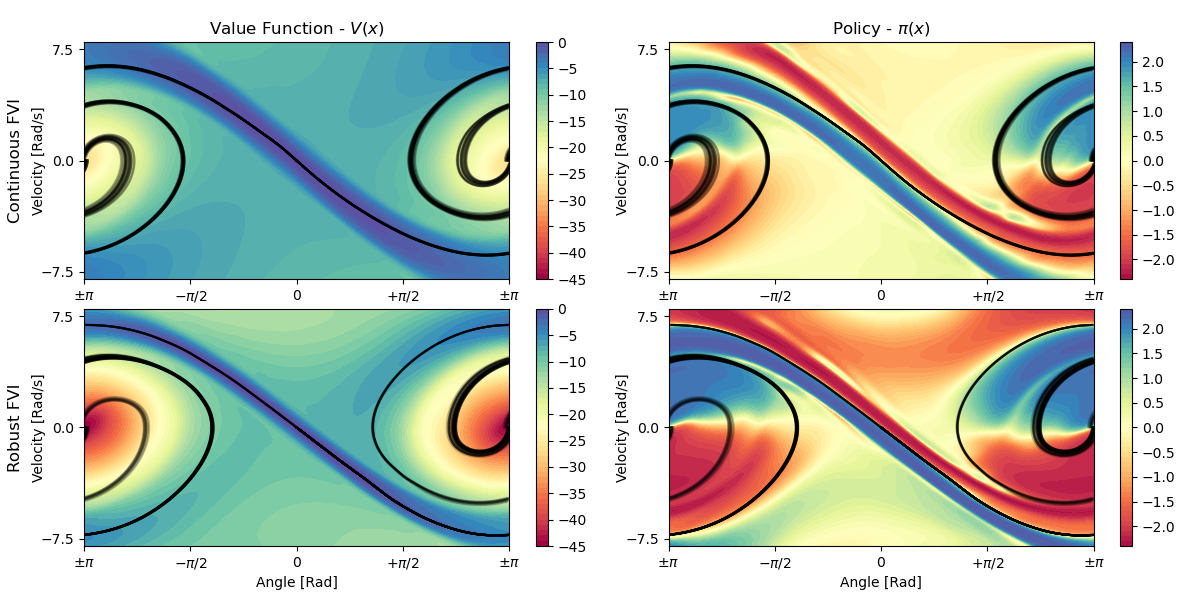The open-source implementation of continuous Fitted Value Iteration (cFVI) as well as robust Fitted Value Iteration (rFVI) introduced in
Abstract: Solving the Hamilton-Jacobi-Bellman equation is important in many domains including control, robotics and economics. Especially for continuous control, solving this differential equation and its extension the Hamilton-Jacobi-Isaacs equation, is important as it yields the optimal policy that achieves the maximum reward on a give task. In the case of the Hamilton-Jacobi-Isaacs equation, which includes an adversary controlling the environment and minimizing the reward, the obtained policy is also robust to perturbations of the dynamics. In this paper we propose continuous fitted value iteration (cFVI) and robust fitted value iteration (rFVI). These algorithms leverage the non-linear control-affine dynamics and separable state and action reward of many continuous control problems to derive the optimal policy and optimal adversary in closed form. This analytic expression simplifies the differential equations and enables us to solve for the optimal value function using value iteration for continuous actions and states as well as the adversarial case. Notably, the resulting algorithms do not require discretization of states or actions. We apply the resulting algorithms to the Furuta pendulum and cartpole. We show that both algorithms obtain the optimal policy. The robustness Sim2Real experiments on the physical systems show that the policies successfully achieve the task in the real-world. When changing the masses of the pendulum, we observe that robust value iteration is more robust compared to deep reinforcement learning algorithm and the non-robust version of the algorithm. Videos of the experiments are shown at https://sites.google.com/view/rfvi
Figure 1: The optimal value function and policy computed using cFVI and rFVI on the torque-limited pendulum. In comparison to cFVI, the min-max optimization of rFVI causes the optimal policy to exert higher actions when deviating from the optimal trajectory. The ridge leading up to the upright pendulum is much smaller to account for potential disturbances.
Example: This example computes the value function of the torque-limited pendulum using cFVI & rFVI. After each evaluation the current policy is used to control the system and the obtained reward is printed. To start training the value function, execute
# Train the value function from scratch
python pendulum_experiment.py -alg [cfvi|rfvi] -load 0 -seed 42
# Evaluate the trained model
python pendulum_experiment.py -alg [cfvi|rfvi] -load 0 -seed 42
Figure 2: The optimal trajectories of the cFVI and rFVI policies on the torque limited pendulum. Both optimal policies achieve the swing-up and balance the pendulum upright. The rFVI policy applies larger actions than the cFVI policy and accelerates the pendulum to higher velocities. Due to the higher actions the rFVI achieves a marginally lower reward than the cFVI policy but is more robust.
Citation:
If you use this implementation within your paper, please cite:
@inproceedings{lutter2021value,
title = {Value Iteration in Continuous Actions, States and Time},
author = {Michael Lutter and Shie Mannor and Jan Peters and Dieter Fox and Animesh Garg},
year = 2021,
booktitle = {International Conference on Machine Learning (ICML)}
}
@inproceedings{lutter2021robust,
title = {Robust Value Iteration for Continuous Control Tasks},
author = {Lutter, Michael and Mannor, Shie and Peters, Jan and Fox, Dieter and Garg, Animesh},
year = 2021,
journal = {Robotics: Science and Systems (RSS)}
}
@article{lutter2023robust,
title = {Continuous-Time Fitted Value Iteration for Robust Policies},
author = {Lutter, Michael and Belousov, Boris and Mannor, Shie and Fox, Dieter and Garg, Animesh and Peters, Jan},
year = 2023,
journal = {IEEE Transactions on Pattern Analysis and Machine Intelligence (TPAMI}
}
Contact:
If you have any further questions or suggestions, feel free to reach out to me via
michael AT robot-learning DOT de

